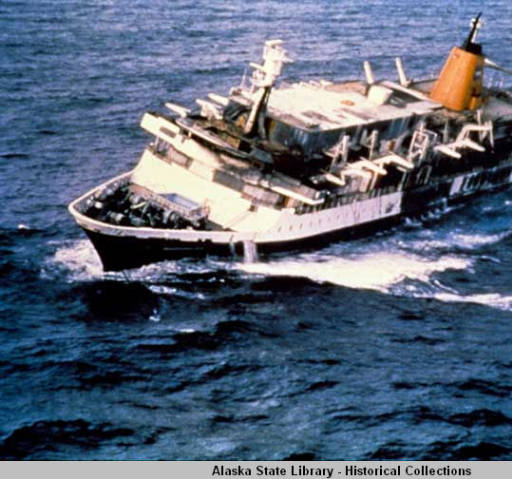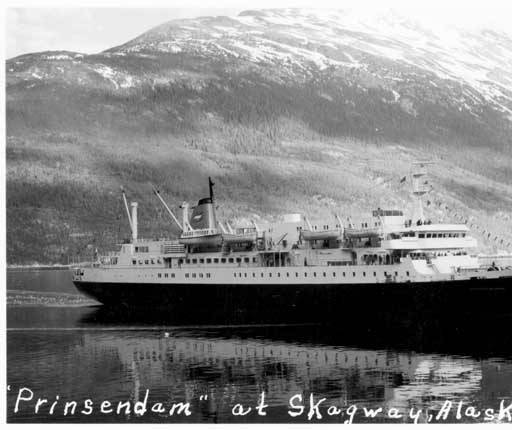
It’s been called the greatest high seas rescue in the history of the Coast Guard. 35 years ago on October 4th, the luxury cruise liner Prinsendam caught fire in Gulf of Alaska, between Yakutat and Sitka. Despite an incoming typhoon, 30-foot seas, and 100-meter visibility, every one of the more than 500 passengers and crew escaped before the ship burned and sank.
Earlier this month members of the US Coast Guard and Air Force, and their Canadian counterparts, gathered in Seattle for a reunion. In Part 1 of a three-part series on the Prinsendam anniversary, KCAW’s Rich McClear headed south to join them – and reflect on his own role in the emergency. 35 years ago, McClear, was about to leave KTOO in Juneau to start the public radio station in Sitka.
Oct. 4, 1980, was Juneau’s 100th birthday and the city was in the mood to party. The Coast Guard Cutter Boutwell was in town, up from Seattle, to help with the celebration. The bars were full of Coasties.
Sitkan Doris Bailey was in Juneau and remembers how her husband, Roy, first learned that the party was over. “Some boat started tooting blasts on the horn and Roy jumped out of bed and said “Oh My Gosh, every coastguard person is being called back to the ship, all leave is canceled,” Bailey said.
That was around 1 a.m. in the morning. The Boutwell’s captain, Lee Krumm, was scheduled to be the Centennial Parade Grand Marshal. He was enjoying himself in a Mendenhall Valley tavern when he was called to the phone.
Lee Krumm: I went up and got the microphone from the band and said, ‘Anyone from the Boutwell in here get yourselves downstairs. We’re heading back on the ship. We have a cruise ship on fire.’ We had people actually sitting in the trunks of cars with their legs hanging out the back getting them back to the ship.
The Juneau police and volunteer fire department went to every bar rousting out crewmembers. Seaman Dan Long was on the ship helping load the crew back on board. Long remembered the process. “One guy take the arms, one guy take the legs, haul them on board and dump them on the flight deck – those guys who couldn’t walk under their own power,” he said.
But in two hours the Boutwell was ready to sail with only nine crew members missing. In Sitka, the Woodrush was also underway and two helicopters from Air Station Sitka were heading to the ship.
Aboard the Prinsendam, the fire spread. She was dead in the water. The captain gave the order to abandon ship. John Graham was the ship’s lecturer and recalled, “In the beginning the seas were relatively calm. We were put into the lifeboats in the middle of the night. It was kind of an adventure. People did sing along to old campfire songs.”
At daybreak, the helicopters started hoisting passengers. They ferried the survivors to the Exxon Williamsburgh, which heard the SOS. Fortunately, the tanker had a helipad and was fully loaded with crude oil, making it stable in the rising seas.
Every few trips the helicopters had to refuel, so they carried their passengers to Yakutat.
Pete Torres was on the crew of one of the Kodiak choppers and said, “The people had been sitting cramped in a lifeboat for up to 10 to 12 hours. By the time they got into the helicopter, they couldn’t get themselves out of the basket. We would actually have to pick them up and move them back to the back of the helicopter.” He added, “There weren’t enough troop seats in the helicopter, so after a while a lot of the passengers would actually have to sit on the deck in a pile. I think on our last run we had up to 16 survivors on our helicopter.”

The Prinsendam passengers who flew to safety may have been the lucky ones. As the day wore on, the weather deteriorated.
Passenger John Graham said this is when survivors in the lifeboats began to feel desperate. “Finally the typhoon hit us full force. Winds gusting up to 60 knots. 30 foot seas. And we were all hypothermic. We were all seasick. At about 5 o’clock, the storm was so bad that the helicopters couldn’t fly anymore. So our only hope was that there something out there on the sea that could rescue us,” he said.
Graham’s boat was eventually found by the Boutwell. She had arrived from Juneau and began taking survivors aboard. It wasn’t easy.
First they sent a launch to transfer survivors from the lifeboats to the ship. That didn’t work so well, Dan Long recalls. “We went out and got to the first lifeboat. Well, the crew from the Prinsendam, they were just panicked. We wanted to take the elderly on board first. They were climbing over the elderly and climbing onto our boat because they were so afraid. It was this total mayhem. Our boat quickly filled up and we couldn’t get the elderly off the lifeboat.”
Instead, the launch towed the lifeboat to the Boutwell, but most were not able to climb the 40-foot Jacob’s ladder to the ship. Their hands were cold, and they could not grip the rungs. Long said, “We just sent a man down with a horse collar and manually hauled them up one by one,” using a hand winch.
And that’s the way the Boutwell brought all the survivors from the remaining lifeboats aboard – or so they thought.
Lt. Colonel Dave Briski, the pilot of an Air Force C-130, was unwilling to call it a day.
Lt. Dave Briski: I called the Coast Guard and I said, “What’s the status of the mission?’ They said, ‘Well, everybody’s been picked up. We’re closing down the mission down.’ And I said, ‘Are you sure you’ve got everybody picked up?’ And they said, ‘Yes everybody’s picked up.” And I said, ‘OK, the last I heard, the Air Force helicopter, the boat they were picking up people from, had two of our PJs, or pararescue men, and about 18 to 20 people from the ship. Can you confirm those people were picked up?” They said ‘Yeah, they’re all picked up.’ I said, ‘Well give me the names of the two PJs and then I know you’ve got ‘em. They insisted they were going to close the mission. I called the Rescue Coordination Center back at Elmendorf and I said ‘Hey, I don’t think they’ve got everybody picked up.’
Briski was right. The Boutwell and Woodrush sailed search patterns in the area where the lifeboat was last reported. Just before 2 a.m., the Boutwell found the missing lifeboat and hauled its passengers aboard. The mission was closed, but for the residents of Yakutat, Sitka and Valdez, the rescue of the Prinsendam was just beginning.
The end of the mission at sea was the beginning of the rescue on land, as the more than 500 passengers and crew of the Prinsendam were brought ashore with only the clothes on their backs. In Part 1 of this series tomorrow, KCAW’s Rich McClear talks with Sitkans who lent a hand – and much more – to the survivors of the Prinsendam.
This story is Part 2 in a series to commemorate the 35th Anniversary of the Prinsendam Rescue. Here is Part 1 and Part 3. Click here for more historic photographs of the Prinsendam sinking, courtesy of the Alaska State Library.
